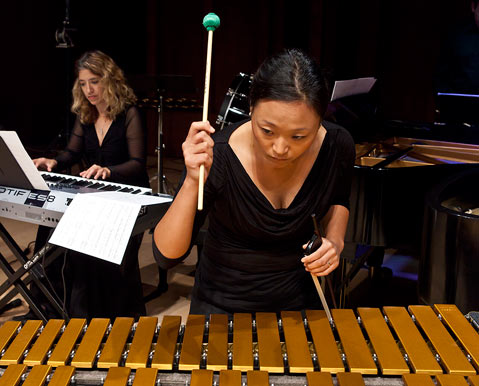Camerata Pacifica Season Begins
A Percussion-Oriented Opening for Adrian Spence’s Chamber Music Ensemble

Camerata Pacifica usually sticks to the traditional protocols of classical performance — subdued formal attire and no amplification — but on Friday night, those rules went out the window with a loud crash, along with some thunks, raps, clangs, whooshes, and a few other sounds that defy description. This innovative group, which has built its reputation on thoughtful interpretations of canonical chamber works, took a brave leap into the world of 20th-century music. The result was a daring experiment, both adventurous and thoroughly enjoyable.
Joanne Pearce Martin began the evening with a lively, insightful interpretation of Rachmaninoff’s Prelude in C-sharp Minor, Op. 3, No. 2, an amazing exploration of the range of the piano’s capabilities that set the mood of the evening well. Next, George Crumb’s 1971 tribute to the voice of the humpback whale, Vox Balaenae for 3 Masked Players, Electric Flute, Electric Cello and Amplified Piano, pushed the limits of musical understanding. Adrian Spence, along with cellist Ani Aznavoorian and pianist Vicki Ray, let this challenging piece tell its story well. The masked musicians (Crumb wanted to put humans in the background) rumbled like whales, squawked like seagulls, and growled like dinosaurs. Still, as Spence ably explained in his preconcert remarks, Vox Balaenae goes beyond mere imitation. The overall shape of the work follows geologic history, and its innovative sounds — the flutist’s voice singing along with the flute, the piano’s strings when strummed by hand, the amplified double-stopped harmonics on the cello — reveal forces even more elemental than the natural phenomena they echo. The work even includes the cacophonous intrusion of humanity, late in the story but devastating in its impact — and a lesson in humility for us all. We are but one small, late, and noisy intrusion in a long and carefully wrought sonata for the universe.
The next piece provided a wonderfully humorous counterbalance to Crumb’s ponderous work. Thierry De Mey’s Musique de Table, for Percussion isn’t really table music (the term signifies background music to be played during dinner) and isn’t really for percussion, as the musicians have no instruments other than their hands. All three percussionists, Ji Hye Jung, Svet Stoyanov, and Michael Zell, sat at a table, as if they were a panel of speakers who could only communicate by running their nails on the cloth, clapping their hands, or drumming on the table in lots of different ways. But they spoke eloquently in their bizarre language, and their deadpan presentation made it even funnier. De Mey, who understands choreography as well as composition, left specific instructions about the visual impact of the performers’ gestures: ostentatiously turned pages, stone faces, hands held aloft in warning and welcome. The oddest thing about it was that everything worked by implication — there was no story to tell or idea to present that could be expressed in words, but everything made sense. Overall, the piece was subtle, sly, and clever.
The final work of the evening, Steve Reich’s Sextet for Percussion and Keyboards, also spoke clearly and even sang. In the able hands of Camerata Pacifica’s two keyboard players and four percussionists (Douglas Perkins joined the other three), Reich’s trademark pulsating syncopations built to a stunning and surprisingly melodic climax. Anyone who finds Reich’s minimalism difficult to enjoy would be pleasantly surprised by this piece. As each performer adds another layer of sound, the simple melody comes into sharper and sharper relief, and the textures created by Reich’s innovative instrumentation become more interesting. The work’s complexity makes it extremely difficult to perform — at one point, two performers used four string bass bows on the sides of vibraphone keys to create an eerie, ethereal ringing, while the others played interlocking yet contrasting rhythms — yet it all fit together. The audience followed with their own performance on percussion: thunderous applause.



